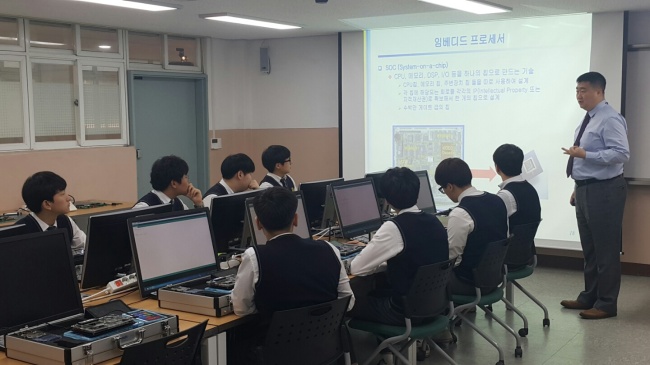Most of this year’s high school graduates will choose to further their education, but Kim Sung-woo has decided to take a different path.
Instead of enrolling in a university, the Steve Jobs wannabe chose to work full-time at a local software developer, hoping to kick-start his career as an IT professional.

Apprentices at Yongsan Technical High School in Seoul train how to make SoC, an integrated circuit that combines components of computers or other electronic systems. (Shin Dong-yoon)
“I’ve already set my goal. I want to become an app developer and one day start my own business,” said the 19-year-old graduate of Incheon Mechanical Technical High School.
In South Korea, where nearly 70 percent of high school graduates advance to tertiary education, Kim may seem unusual. However, the teenager is among a small but growing number of young South Koreans who forgo what they see as costly and pointless university education in pursuit of their dreams.
He is also among the first batch of 461 students who completed a two-year apprenticeship program, introduced in 2014 as part of the country’s efforts to promote vocational high schools -- often looked down on here as a place only for low achievers.
The apprenticeship program started off with nine high schools nationwide in partnership with 15 small and medium-sized businesses. Of the first-batch of graduates, 80 percent have found jobs, the Education Ministry said.
During the two-year course, students split their week between theoretical education at school and on-the-job training at actual workplaces.
Companies registered with the program offer training on skills that they need, following the National Competency Standard, the country’s measure for occupational proficiency in industrial sectors. For employers, the program provides an opportunity to invest in the creation of the right talent pool from which they will hire.
With the nation’s job market for college graduates deteriorating, the program has gained traction.
Schools and workplaces participating in the apprenticeship course have risen to 60 and 198, respectively, this year.
The Education Ministry, which has spent 60 billion won ($521 million) since the program’s inception in 2014, plans to expand it further to 200 schools by the end of this year, said Kim Hong-sun, an Education Ministry director who oversees the program.
“The apprenticeship program in high school is a win-win for both apprentices and employers, as it gives potential employees a head start in work skills. (Employers are also satisfied) because the apprentices are familiar with their work culture and show loyalty,” he said.
Currently, this model is largely limited to blue-collar fields such as manufacturing, machining, molding and welding. But with the advent of “Industry 4.0,” which blurs traditional boundaries between blue-collar and white-collar workers, the program will be applicable to a much wider range of industries, the official said.
“The coming Industry 4.0 will open up countless, unimaginable business opportunities” in what we now perceive as blue-collar, the ministry official said.
Some even say apprenticeship is one answer to the country’s job-skills mismatch. “New technologies transform work across industries and we need new models to train young people,” said Kim In-suk, a researcher at the Korea Research Institute for Vocational Education and Training.
“College degrees alone will not help one build new skills to adapt to the ever-changing labor market in the era of Industry 4.0.”
Despite the bright prospects, parents’ obsession with their children’s university diploma is a major barrier to the model’s broader takeoff, education officials said.
There is still the widespread perception among parents that a college diploma is essential for a higher-paying job and fulfilling life.
The Education Ministry Director Kim also stressed that the apprenticeship is not about churning out low-paying jobs.
“It’s (creating a talent pool) from which employers can recruit high-potential workers who would later on play important roles in their companies,” he said.
Park Sang-ho, a second-year apprentice at Yongsan Technical High School, said he chose to take the course because he did not want to be one addition to the tens of thousands of jobseekers applying for Samsung.
“I didn’t want any student loan, and plus, there are simply too many college graduates right now, who are all aiming at one job, like Samsung,” he said.
“I think by the time I complete the apprenticeship and graduate from the school, I will have a more promising future.”
By Bak Se-hwan(
sh@heraldcorp.com)






